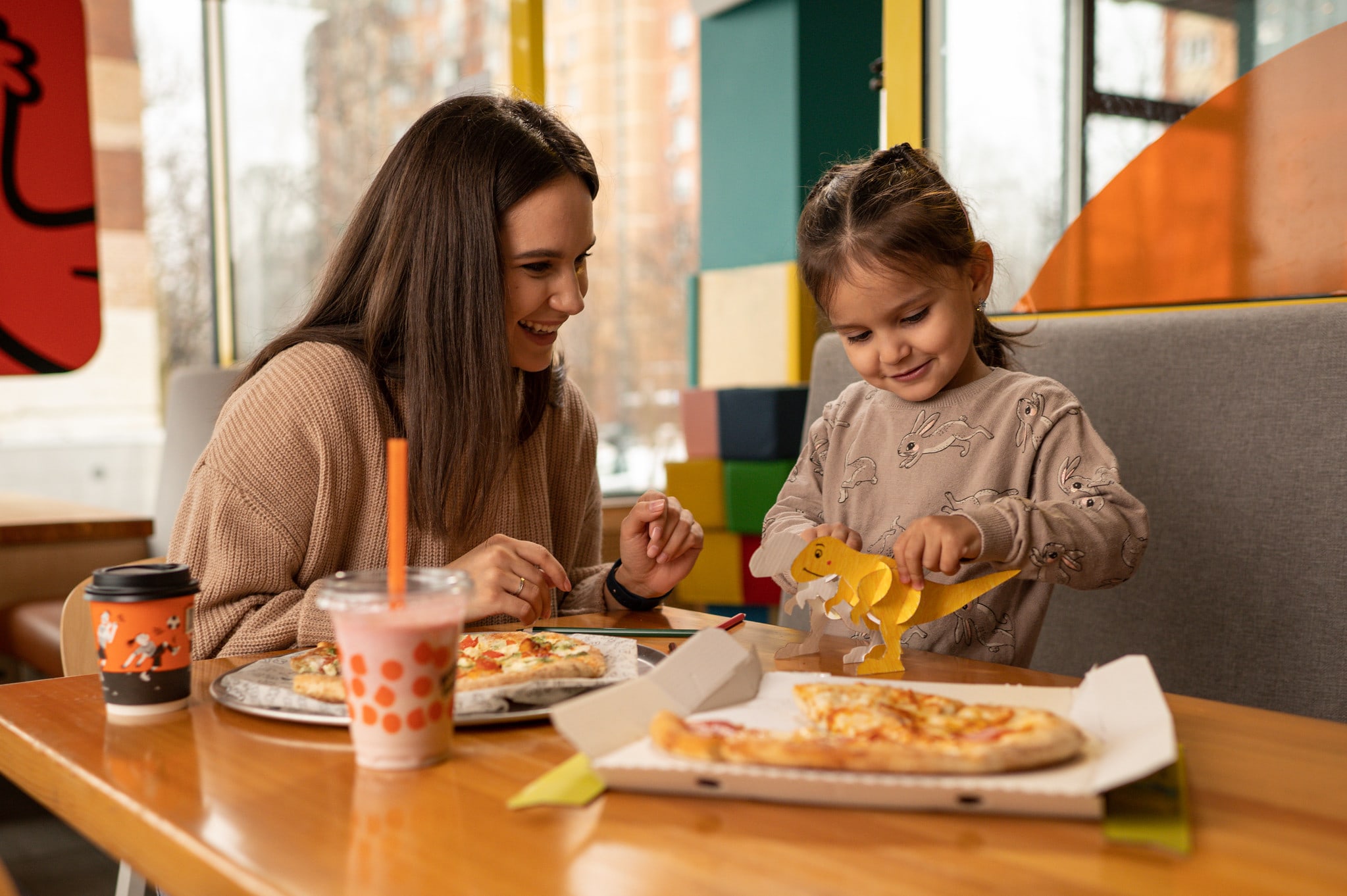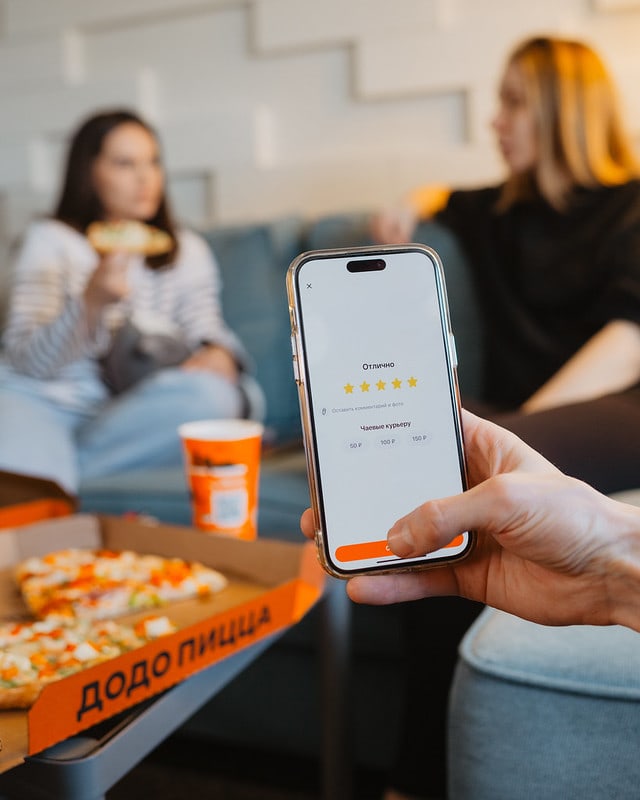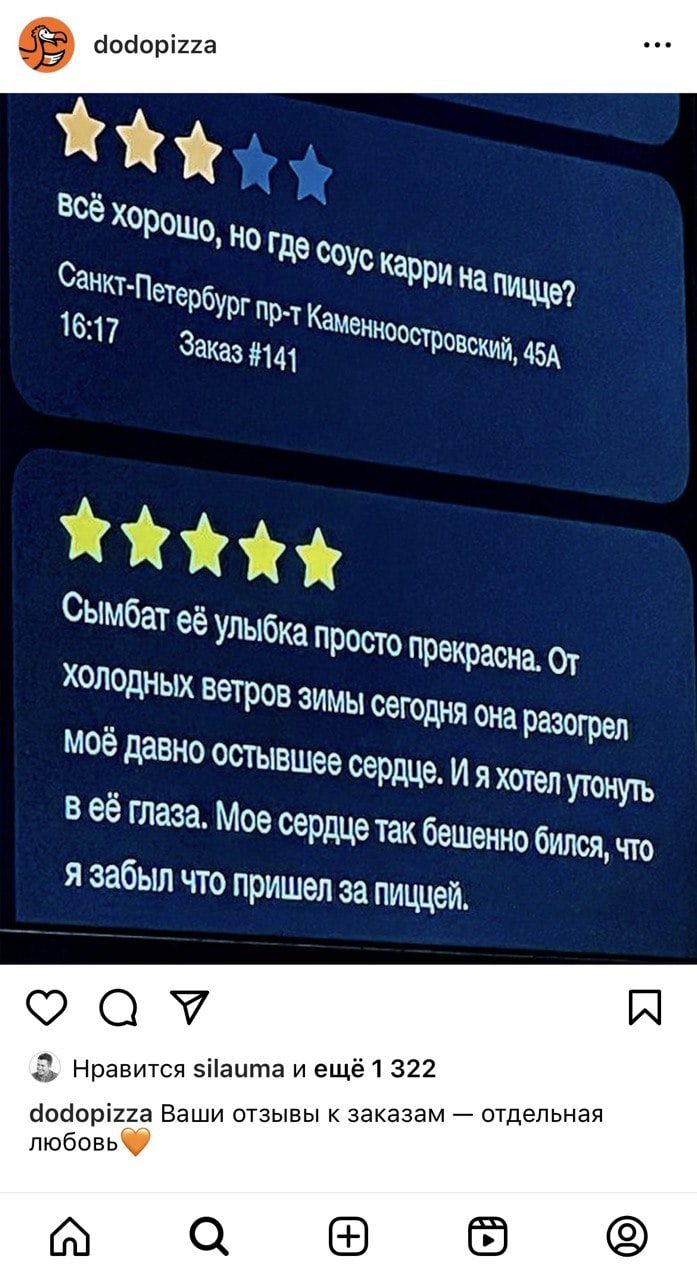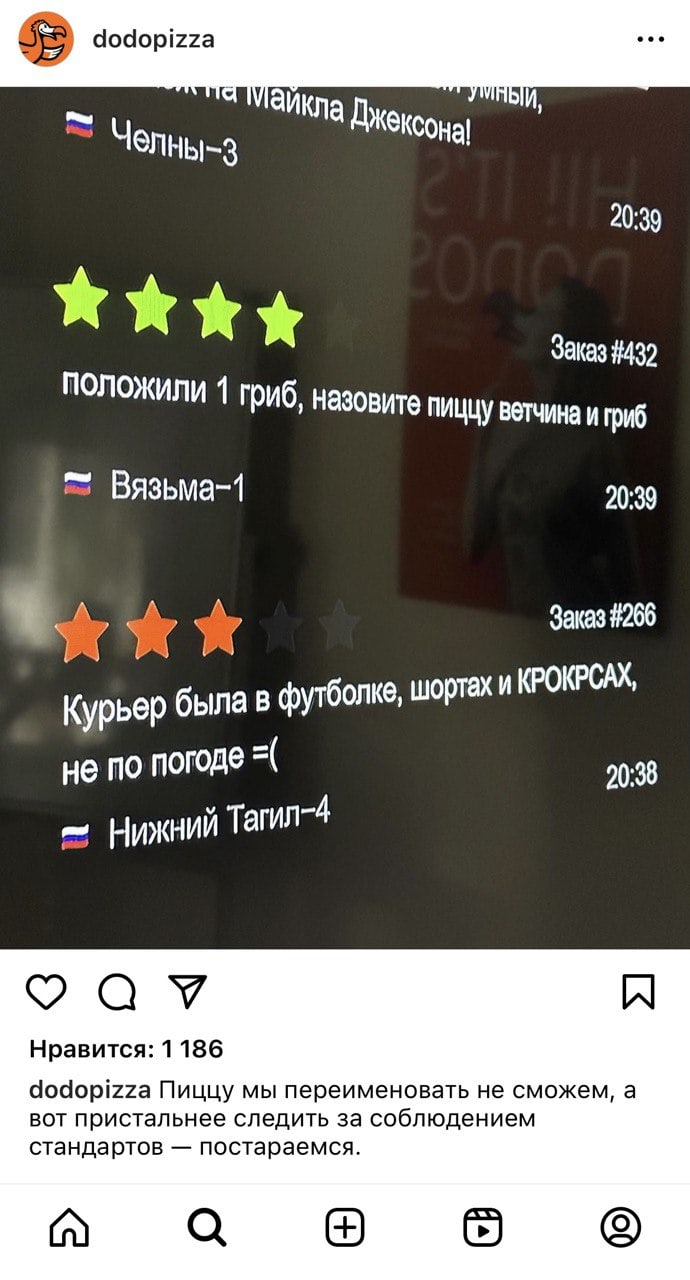Creating content for social media
What are values and attributes
Values are what we ourselves consider important, what we truly believe in, what we strive for. And at the same time, they are what our customers value in us, why they choose us and distinguish us from others.
Dodo has 5 values: availability, attentiveness, trust, openness, and quality.We tell in our brand book what we mean by these.
If we are asked: "How do your values manifest themselves in real life?", we'll talk about our attributes, the things we're loved for. They are: pizza experience, delivery, pizzerias, our app and support service.
Values and attributes are intertwined and they reinforce the brand image in the world's eyes. Values set the brand identity, define standards. Attributes specify how these values are ensured in products, services, or interactions with customers.
In social media, we talk about attributes, and thus show that Dodo follows its values in real life.
Who we make content for
The core of our target audience is difference makers, people who care. They are active and demanding: if something goes wrong, difference makers will report it to our support team to make sure it won't happen again - neither to them, nor to anyone else.
Difference makers help us to improve, they inspire us and give meaning to what we do. We want our communication to hit straight into their hearts.
External manifestations of this image:
- Constant movement. Our main character is always busy and passionate about something. They have a lot to do: work, hobbies, family, friends.
- Care for others. They are often the organizers of a meeting, they share pizza with friends willingly, they often order food for the loved ones.
- Conscious recreation, not hedonism. The protagonists in our photos are resting, but the context always suggests that they are having a break after an energetic activity or in the middle of ones.






General principles for Dodo social networks
Dodo social media pages constantly broadcast sincere and vivid content. Both in the narrative and its form. We talk about our processes openly, showing what remains behind the scenes, and do not camouflage mistakes.
We do not try to create a perfect picture. We want to enter the users’ feeds organically and become just a friend whom they’re subscribed to. A friend who often has something going on and demonstrates it in a cool manner and in a lifestyle format - without the help of lighting or food stylists.
Here's what helps us make this sincere and vivid content:
- We talk about important things and fulfill our social mission. We do not avoid the social context; we respond to social changes. We speak out on topics that do not divide society into those who agree and those who disagree. For example, we celebrate such uniting holidays and small good events as New Year, St. Valentine’s Day, Pizza Day. And we don't get involved in religious, military and political holidays, nor do we launch campaigns on days of mourning.
- We show what happens inside and behind the scenes: how we produce flour, brew coffee, and develop a mobile application. Such content brings us closer to the audience and introduces our customers to the large team of caring people who create Dodo Pizza.
- We prioritize live photos. To take a vivid shot is more important than to take a beautiful one. We only take photographs of real products: we do not use glue instead of cheese; pizza for filming is ordered in actual pizzeria and shot as is – same product that any guest would receive.
- We show real people. We talk about our customers and the situations that happen in their lives; take photos of our visitors.
- We reveal consumption patterns. People eat pizza at home, in the office, at university, on holiday or at a picnic - and we show it. Food is part of our protagonists' lives, and we, as a brand, accompany them in various different moments.
- We make emotional content and build connection with the audience. We don't show the product and promotions only; we talk about what is important to our subscribers.
Visual style
Dodo is a new brand in the international market, so it's important for us to work on raising recognition. We use the key visual elements in communication:
- logo,
- primary and secondary colours,
- packaging,
- style elements,
- photographic style.
During photo shooting, we follow this principle: to take a “true” shot doesn't mean to take a bad one. We don't involve props masters, food stylists or professional photographers; we take what everyone has on hand. Like a cell phone, sunshine and a pizza from our store. We make it all as beautiful and appetizing as we can.
Learn more about our approach to photo shooting in "Conducting a Dodo Style Photo Shoot" guide
Themes and content: what we talk about
About why we're loved. At the heart of it all is the Pizza Experience. It's both great pizza and an outstanding experience: indulging menu, delicious food, convenient app, comfortable pizzerias, the speed of our operation, and a friendly and helpful staff.
Product
If we're talking about the food, here are the product features we highlight:
- fresh ingredients;
- consistent quality;
- special dough: we proof it for 3 days to get those very bubbles, airy consistency and flavour;
- interesting combinations, unique ingredients;
- local specialties of products;
- food for people with different preferences: we have a children's menu, meatless and porkless pizzas, as well as options for those who like it spicy.
- constant flavour regardless of location - thanks to a unified platform Dodo IS;
- customization: the guest can choose what they want to have in their pizza and what not.
How we talk about it:
- We focus on flavour, quality and variety of products. Show various products: pizza, dodsters, soups, appetizers, desserts and drinks. We highlight local specialties, not just the classics.






- We feature the product in the context of consumption, not detached from reality. We take photos of the product in the pizzeria: on the counter, on the table, on the background behind the people. Or in the context of life of our characters: at home, in the office, on the street.

On a tray in a pizzeria 
A picnic on a lawn 
In a car - We show food and drinks as they are in real life. We aspire to bring expectations and reality as close as possible. We work with light and angle, trying to not "overcook" the picture in post-processing. We rely on sunlight if it is possible.

Good shots. Both photos are made on the phone, without any professional lighting Dodo

Photos taken on a phone have more credibility because customers look at something through the lens of their smartphones every day. The product is seen as something you want to eat Not Dodo

A professional photo is perceived as a picture from the internet that took a whole team to work on. The product seems fake, you don't want to eat it - We rely on the actual properties of food when describing the product. For example, we might say the food is crunchy, stretchy, aromatic, fresh, bouncy, golden, or hot.
- We avoid words that refer to concepts and abstract images. We don't use such words as "exquisite", "delicate", "bold", "explicit". Dodo is simply delicious, appetizing pizza that meets the expectations of our guests.
Delivery
It is also a part of the pizza experience. It's crucial for us to show that Dodo has its own delivery, and also that it's really cool.
So here are the features wee highlight:
- speed and accuracy at all times, even in rush hours;
- cleanliness and neatness;
- polite couriers who are happy to do their job;
- food arrives hot.
How to talk about it:
- We convey dynamics, movement. We show regular situations of interaction between the courier and the customer: the journey, handing the order in, checking the mobile application.
- We show courier delivery in different locations and circumstances: at home, in an office, a large order, summer, winter, morning, evening.

Courier rushing to the customer, and it looks as if we accidentally took a picture of him driving by. 
Courier using the app 
Courier in the city - We show the outfit, highlighting that each courier has their own clean and neat uniform and a special thermal bag to keep the delivery warm.

Video screenshot: showing the courier’s uniform 

Courier outfit in the context of real order fulfillment - We avoid situations in which it’s obvious that the photos are staged. We try to make the content as close to Dodo couriers’ real everyday life as possible, without any faking.

Beautiful shot, you can clearly see the uniform of the courier and the pizzeria. But it is clear that the courier is posing for the photo deliberately 
The courier is looking at the camera and posing. The photo does not reveal the attributes of our delivery at all
Pizzerias
In any city, Dodo Pizza is a trusted place where everyone feels comfortable. You can come to us on your lunch break, for dinner with the kids, or have a sit-down with friends. We have a friendly and helpful team, and we also have very cozy and clean stores.
Here are the key features of our pizzerias:
- modern look and comfort inside;
- clean hall;
- open kitchen;
- accessibility for people with disabilities;
- kids' indoor playgrounds and workshops for children;
- the team’s fundamental attentiveness.
What we talk about:
- Exterior and interior of the store: where it is located and what are the surroundings; how everything looks inside: we convey the atmosphere, comfort, pizzeria’s vibes, and also tell you that we have outlets, Wi-Fi and parking lots nearby.

The outside view on the pizzeria 
We convey the atmosphere of the pizzeria: a cozy and clean room, guests eating and socializing Features in our pizzerias - Accessible environment elements: ramp, handrails, accessible toilet, special marks.
- An open kitchen and tours around the kitchen: guests can discover how our product is created. And also to see that there's a friendly atmosphere among the Dodo team.

Working moment. Natural situation and emotions of the characters, which we can observe through the glass in the pizzeria 
Our restaurant guest observing the working process - Pizzeria kitchens with details, for example, the marks on the containers or our refrigerators. These elements reveal how we "go over the top" with things.
- Everyday tasks from the team’s point of view in video format. We talk about the internal process of the business: why we do things this way and not that way. For example, why we don't use gloves.

Video screenshot: talking about an updated recipe and showing the cooking process 
Video screenshot: talking and showing why we don't wear gloves - Children's indoor playgrounds and pizza making workshops: highlight that our pizzerias are a great place to spend time with kids.


Sincere emotions, children are engaged in the game, we caught this moment 
Video screenshot: showing children's workshops
App
Our app is not just good: it is really good. Besides the standard features of all delivery apps, it has many others that are so convenient and handy for users.
We've gone over the top with it.
Here are the key features of our app:
- user-friendly and informative interface;
- adapted for people with disabilities;
- different scenarios of ordering and receiving the order: table ordering, pickup;
- order preparation tracking;
- webcam broadcast to watch the order being prepared;
- calories and macronutrients information for each product;
- opportunity to give detailed feedback;
- loyalty program: profitable combos, cashback, promo codes, personal missions;
- ingredient customization and combo builder.
How to talk about it:
- We show all significant app usage scenarios: ordering at home, table-ordering at a pizzeria, leaving feedback, and visually impaired people using the app.

Ordering at a pizzeria via app - Always place brand elements in the frame, whether we see the app screen or not.
- Set a realistic background: where it happens, who makes an order, foods that they order; if they leave a review - the moment when it happens. For example, demonstrating the process of choosing pizza in the app if a person approaches the pizzeria or is at home is relevant, but if so, we need to show the character without food in their hands and around them.
Dodo

Tried the pizza, left a review. It makes sense Not Dodo

The pizza has already arrived, and the characters are still choosing it on the app. It’s a logical error - We tell about the app in the format of short videos, so the information is better perceived. Give a short instruction on how to use a particular feature of the app. One video - one function. Do not overload the video with information.
- Reveal opportunities for customization. In this context, technology is Dodo's strong suit, so we do not forget to highlight it. We say that there is an opportunity to order a product taking into account individual picks and preferences in our application.


Support
We take feedback very seriously: we always respond, we admit mistakes openly, and we deal with every incident quickly and with trust in our guests.
Here are the key features of our support and feedback handling:
- timely service;
- open rating of pizzerias on the website;
- easy-to-use order rating form in the app;
- trust in guests and employees;
- responsive, attentive to every problem contact center specialists.
How to talk about it:
- Admit mistakes. Show that we are not perfect, but we are ready to evolve. For example, we can make a post about getting 3 stars for delivery and tell how we'll fix it.

An example from the dodopizza account: how we turn order reviews into the social networks content 
- Make a post about the opportunity to become a quality inspector and check Dodo's standards.

Video screenshot: talking about what an inspector's job looks like 
- We demonstrate care. We catch those moments when our staff members interact with guests, not just smiling, but doing something helpful. When posting about service, we always talk about the benefit to the guest.
Dodo

A cashier helps a guest to choose a pizza. We caught natural emotions 
The staff member brings the order to the table and chats with the guests about something. You can feel that the characters are not posing 
A young guest gets their pizza. The characters don't notice us taking a shot of them Not Dodo

The picture looks promotional. The character has an unnatural posture 
Again, unnatural posture and smile 
The story is good, but the composition is not: the gray back of the sofa is in the foreground
Content localization
Partners from different cities and countries can use materials prepared by the management team, but each local pizzeria still tries to create their own content. This helps to better engage with the local audience, and people develop a sense of belonging to such content.
How we localize content:
- We show the interior and exterior of local pizzerias.
- We take photos of guests living in a particular location.
- We tell real life stories of pizzeria staff members and guests.
- We study the habits and behavioral patterns of the local audience to create content that meets their needs and expectations. It makes communication more natural.
- We introduce people who create the product to our audience.
- We take into account the unique characteristics and mindset of the country to make content more relevant and clear to the audience.
We have compiled the basic principles of Dodo's communication in social networks in this guide. All recommendations can be taken as a basis and adapted to the needs and features of your local market or community.
Read next:



